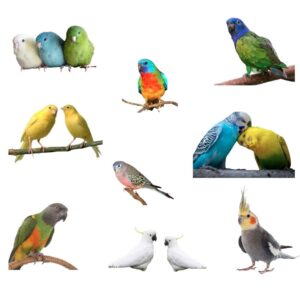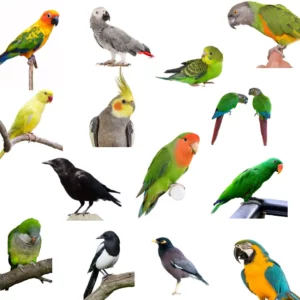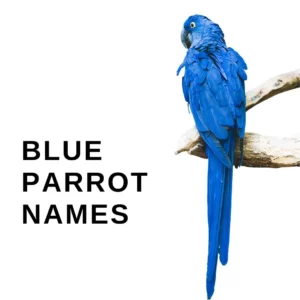The longest-lived pet African Gray, we know of, was Tarbu, a 55-year-old. This gorgeous bird had a loving home and according to his owners, an eventful life.
In general, parrots’ lifespan is quite long compared to other pets. Although it’s hard to estimate longevity, great care greatly impacts African Gray’s.
So let’s talk about the lifespan, things you should watch for, and what you can do to have a lifelong, healthy companion.
Table of Contents
How long do African Grays Live in The Wild?
In the wild, African Gray parrots are among the long-lived birds, with an average lifespan of 22.7 years. This bird is also known as Psittacus Erithacus and has two distinct types of species:
- Congo African Gray a more common and better-known species who have lighter colors.
- Timneh African Gray is a less common but well-known species with darker colors and is smaller than Congos.
Life for African Grays and other parrots in the wild can often be harsh.
Here are some of the most impactful factors that can lead to a shorter lifespan of an African Gray:
- Predation by large animals (hawks, vultures, monkeys, etc)
- Diseases
- Extreme weather changes in the environment
- Deforestation
- Pesticide contamination in the environment
- Hunting in their native region
What Is the African Gray Parrot’s Lifespan As a Pet?
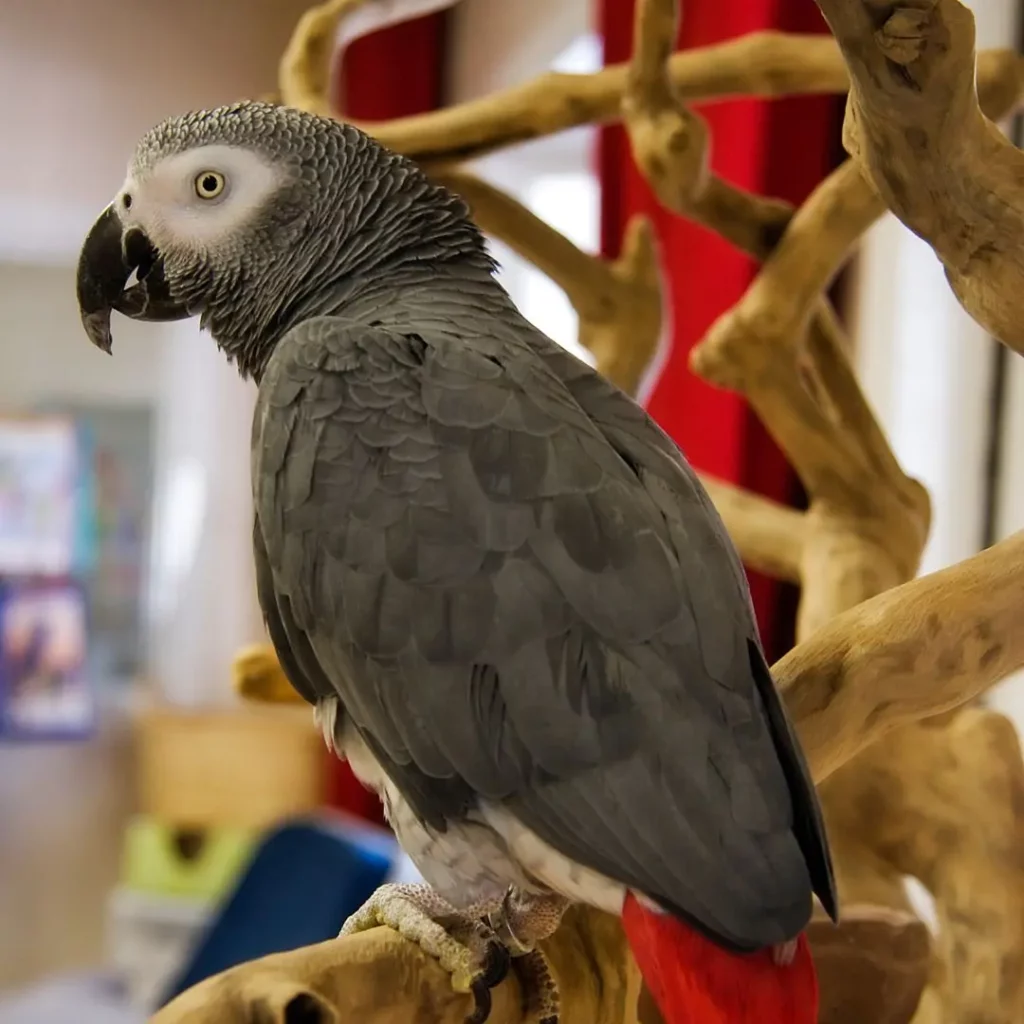
When it comes to domesticated African Grays, they tend to live significantly longer than wild ones. A pet African Gray can live from 40 to 60 years on average. This is mainly due to the following reasons:
- A more balanced and healthier diet
- Less stressful environment
- Proper hygiene
- Supplements
- Mental stimulation
- Socialization
- Medical attention
African Gray Life Stages
1. The Beginning (Hatching):
African Gray Parrots start their life in a tiny egg, hatching into adorable chicks. The journey from egg to chick is a delicate process that sets the stage for their lifespan.
2. Early Years (0-5 years):
Just like human toddlers, young African Gray Parrots are full of energy and curiosity during their early years. This stage plays a crucial role in their overall development.
3. Adolescence (5-10 years):
As these parrots grow, they enter their teenage years, showcasing personality traits that will stay with them throughout their lifespan. It’s a dynamic period of change and adaptation.
The Prime Years
4. Adulthood (10-30 years):
African Gray Parrots reach adulthood around the age of 10, bringing stability to their behavior. This is often the longest and most rewarding stage for both the parrot and its owner.
5. Peak of Wisdom (30+ years):
Entering their thirties, these parrots are at the pinnacle of their mental faculties. Known for their exceptional problem-solving skills and vast vocabulary, they become cherished members of the family.
Are African Gray Parrots Endangered?
Yes, since 2016 African Grays have been an endangered species. IUCN (The International Union for Conservation of Nature) officially classified the African Grays as endangered birds and placed them on the Red List.
Sadly, one of the biggest reasons for their endangerment is wildlife trafficking. More precisely, excessive capturing for international trading and breeding – both legal and illegal.
Due to excessive trapping and difficult living conditions in their habitats, the number of these fascinating birds is gradually decreasing.
Note: We don’t support the illegal bird trade, but we stay behind bird parents who offer a loving home to rescue birds and birdy parents who purchase their pet birds from humane breeders or adopt them.
Health Problems That Affect The Lifespan of African Gray Parrots
While African Gray parrots can live long in captivity, we should never forget that they’re still quite sensitive birds, just like any other parrots. This is why it’s critical to know about the common health problems that may occur and how to address them.
Note: Remember that African Gray parrots can be quite demanding pets when it comes to care, so they may not be the best birds for beginners.
Here are the most common health issues that can negatively affect the African Gray parrot’s lifespan:
- Fungal infections: African Grays are sensitive parrots, so they’re susceptible to fungal infections, often manifesting as respiratory issues or skin lesions or beaks.
Aspergillosis is the most common and dangerous fungal infection in birds, and it happens due to exposure to moldy environments.
However, proper hygiene and a clean living space can help prevent these infections. So, make sure you clean your birdie’s cage daily.
- Bacterial infections: Infections by bacteria, such as Psittacosis, are another common infection in African Grays. Symptoms include lethargy, respiratory distress, and nasal discharge.
Maintaining a clean environment and sticking to regular veterinary check-ups are critical measures for early detection and treatment of these infections.
- Tapeworms and bloodworms: Parasitic infestations, such as tapeworms and bloodworms, are some of the most life-threatening infections in African Grays.
The most common symptoms are weight loss, lethargy, and digestive issues. Regular deworming, a hygienic living environment, and providing a balanced diet can help prevent these parasitic infections.
- Nutritional insufficiency: A nutrient insufficiency can lead to various health issues. For example, parrots require plenty of calcium, minerals, and vitamins – especially vitamin A.
A calcium deficiency may result in weak, brittle bones. On the other hand, Vitamin A deficiency can cause several problems:
- Nasal discharge
- Sneezing
- Periorbital swelling
- Conjunctivitis
- Dyspnea
- Polyuria
- Polydipsia
- Poor feather quality
- Feather picking
- Anorexia (rare, but happens)
Pro tip: A balanced diet with a mix of pellets, fresh fruits, and vegetables is mandatory to prevent nutritional insufficiencies in your parrots.
- Rhinitis: Rhinitis, or inflammation of the nasal passages, can occur in African Grays due to various factors, but mostly infections or irritations due to dirt and dust – symptoms often include sneezing and nasal discharge.
So, provide your African Gray parrot with a clean and dust-free habitat to help prevent rhinitis.
- Psittacine beak and feather disease: PBFD is a viral disease that affects the feathers, beak, and immune system in birds. African Grays may show feather abnormalities, beak malformations, and susceptibility to secondary infections.
This disease is highly contagious, requiring quarantine measures and regular observation by an experienced vet.
Remember: If you notice any symptoms that may indicate these health issues in your African Gray, don’t hesitate – be sure to take your birdie to a vet immediately.
Factors That Shorten the Lifespan of African Gray Parrots
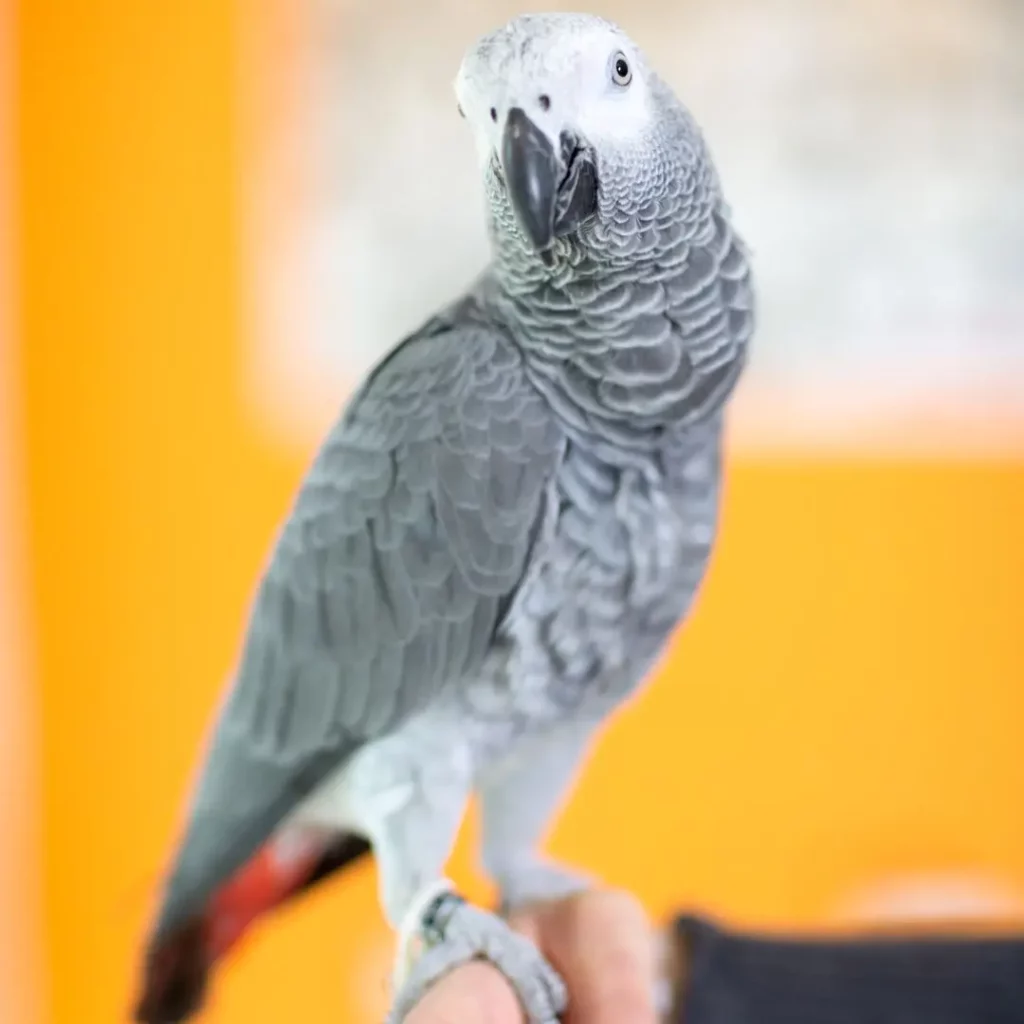
Unhealthy/unbalanced diet: Parrots are sensitive pet birds who often experience health issues due to an inadequate diet, and African Grays are no exception. For instance, a diet often restricted to seeds and water can result in malnutrition. This lack of vital nutrients weakens their immune system, making them more susceptible to diseases and reducing their lifespan.
Limited space: A confined living space, crowded with objects, interferes with the natural behaviors of African Grays. A limited space means limited movement, more precisely, flying. Physical inactivity affects their weight and contributes to cardiovascular issues, impacting their lifespan.
Lack of mental stimulation: African Grays are some of the most intelligent and interactive parrots you can keep for pets. Insufficient activities can lead to unhealthy habits, potentially causing health problems – for example, African Grays who don’t have enough exercise and mental stimulation experience anger issues and other improper behavior.
Late treatment of diseases/vet visits: Birds are masters at hiding illness, and delayed veterinary attention can cause even more problems. Not addressing health issues promptly can allow diseases to progress to a point where treatment becomes challenging or ineffective, resulting in a shorter lifespan.
Unsafe environment: African Grays are sensitive to various toxins present in their environment. Exposure to household chemicals, smoke, or toxic plants can lead to respiratory problems and potential poisoning.
Social isolation: Although this is a more indirect factor, it’s still important to understand its potential impact.
An African Gray parrot is one of the most social pet birds that talk. Isolation and lack of interaction with humans or other birds can lead to stress and emotional problems.
Socially deprived parrots may develop behavioral issues, negatively impacting their mental and physical health and indirectly shortening their lifespan.
Prolonging the Lifespan of Your African Gray Parrot
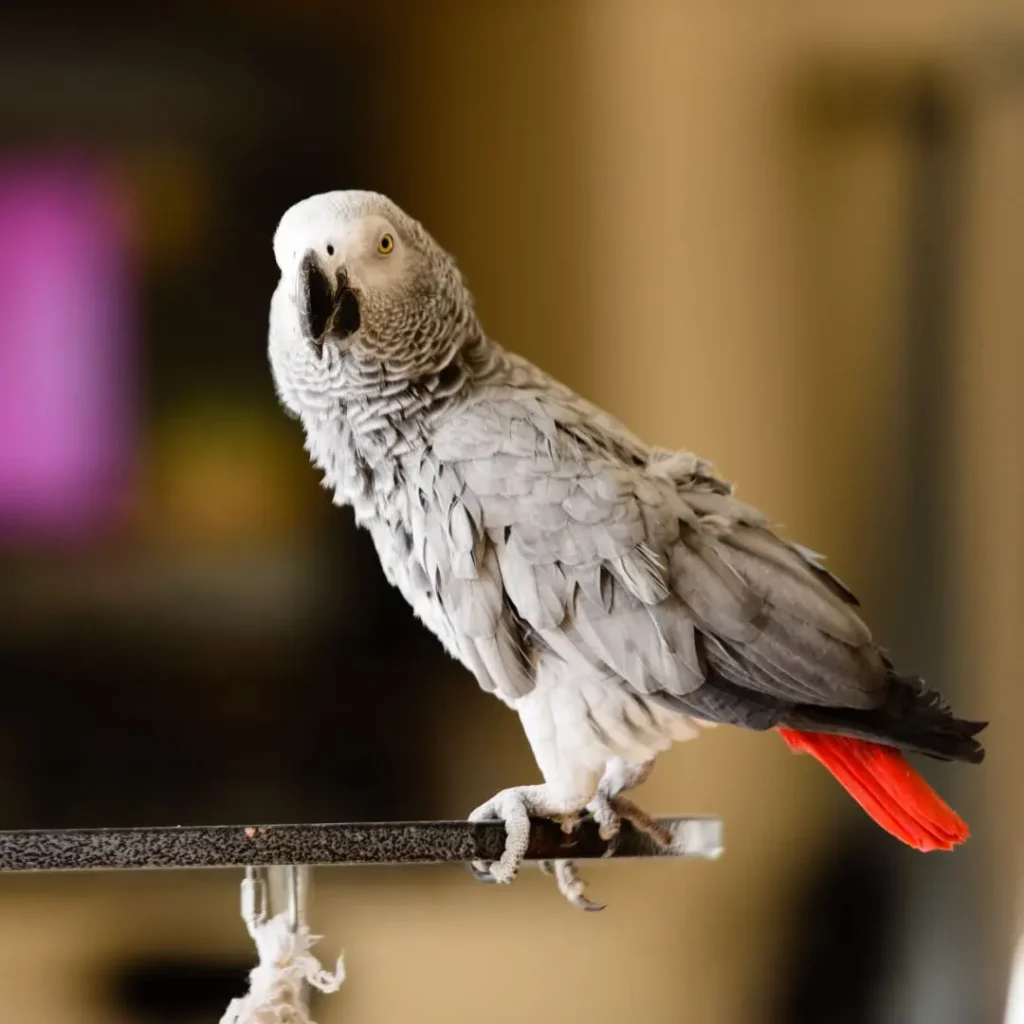
- A proper diet: A balanced and healthy diet is mandatory for the optimal health of parrots. You should provide your African Gray with a mix of pellets, seeds, vegetables, fruits, and occasional treats. But remember to keep it moderate; otherwise, this can lead to obesity and nutritional imbalances.
- Foraging behavior: Due to their intellect and incredibly interactive nature, they must keep their minds and bodies active for a healthier and longer life.
That’s why African Grays need to learn foraging behavior from a young age, such as learning where the food is located and how to bring it from one place to another.
- Exercise and mental stimulation: Due to their intelligence and play, physical and mental stimulation are equally important as teaching African Grays foraging behavior.
For example, training them to land on your hand or bring you an item (such as a bird toy) is a great way to exercise them.
Teaching African Grays the names of objects, colors, and materials can be an excellent way to keep them mentally stimulated.
- A roomy cage/housing: Although African Grays are not large birds, they still need a spacious cage that accommodates their natural behavior, such as sleeping, resting, eating, etc.
Of course, depending on your time and effort, you might also teach your birdie to do these activities outside of the cage. In this case, the room should have plenty of free space, so your African Gray can roam freely without injuring themselves.
Also, ensure the cage is placed firmly to avoid wobbling and potential falls.
It’s also important to place the cage in a draft-free location with good air circulation.
Pro tip: Avoid placing the cage next to the windows or doors, as opening and closing them can easily spook out your bird, leading to panicking and potential runaway.
- Stress prevention: African greys are highly social creatures and can experience stress from loneliness, isolation, and improper petting/handling. While it’s important to socialize with your parrot, it’s critical to learn what your bird likes.
Otherwise, it can become stressed out and distant towards you, especially with improper handling. The most common behavior African Grays develop due to stressful situations is feather plucking.
Remember: Feather plucking doesn’t only occur due to stress. It also happens due to a lack of vitamins and minerals from improper diet, insufficient sun exposure, skin irritation, and other health problems.
Provide safe and destructible materials for shredding, such as untreated cardboard, paper towel rolls, or sisal rope. This helps satisfy their chewing instincts and redirects their attention from potential plucking.
- Create a safe environment: Ensure your home is free of hazards, such as toxic plants, unsecured wires, and open windows.
- Maintain proper hygiene: Just like with us, hygiene plays a vital role in a bird’s health. So, regularly clean your parrot’s cage and food dishes to prevent the spread of bacteria and parasites.
- Veterinary care: Regular checkups with a veterinarian are necessary for early detection and treatment of potential health issues. Prompt interventions can significantly improve your parrot’s health and lead to a longer lifespan.
How To Determine the Age of Your African Gray Parrot?
First, it’s important to understand that it’s never possible to tell exactly how old your African Gray is unless you’ve been there since it was born. But there are still some ways to tell the approximate age.
The most accurate way to determine the exact age of your African Gray parrot is to use a DNA test. On the other hand, you can also check when it was born, by asking the breeder or adoption center where you got it from.
But there are factors to consider that can help you determine the approximate age of an African Gray. Here’s what you can look for:
Eye Color
The most popular and relatively accurate way to determine the age of your African Gray parrot is to observe their eyes.
Ornithologists suggest you can tell their approximate age by the color and hue. For instance, an African Gray is born with black eyes, slowly changing to gray and then yellowish over time.
For example, here are a few guidelines to follow:
- Newborns and a few months old: Young African Grey parrots have completely black eyes when they’re born.
- A few months to a year: As the parrot ages, the black iris develops a lighter gray ring around the outside edge.
- One to three years: The gray ring expands, gradually replacing the black until the iris is light gray.
- Four years and older: The light gray iris matures into a vibrant yellow, marking the parrot’s adulthood.
Tail-feather Tip
You can also look at the tips of your African Gray’s tail feathers. Babies and young parrots have dark gray areas on the tips of their tail feathers.
These areas gradually reduce in size until, in most cases, they completely disappear – typically during the first few years of age.
Beak
Another great way to tell whether your African Gray parrot is old or young is to check its beak length. While they’re young, the upper side of the beak tends to be slightly, but still noticeably longer than the lower side.
So, the longer the beak, the older the parrot is. Though this is a less common and accurate method.
My Senior Paws is a participant in the Amazon Services LLC Associates Program, an affiliate advertising program designed to provide a means for sites to earn advertising fees by advertising and linking to Amazon.com. We also participate in other affiliate programs which compensate us for referring traffic.

